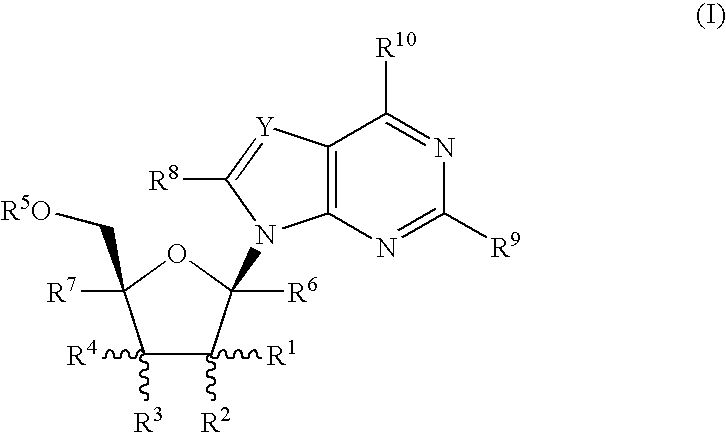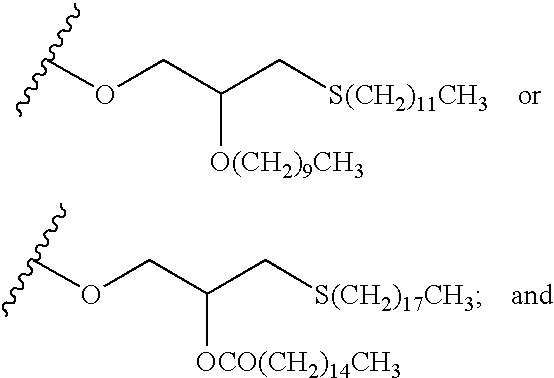Nucleoside derivatives as inhibitors of rna-dependent rna viral polymerase
a technology of rna-dependent rna and nucleoside derivatives, which is applied in the field of nucleoside compounds, can solve the problems of limited clinical benefit, no established vaccine for hcv, and treatment of hcv infection
- Summary
- Abstract
- Description
- Claims
- Application Information
AI Technical Summary
Benefits of technology
Problems solved by technology
Method used
Image
Examples
example 1
2-[2-Amino-6-(2,2,2-trifluoroethylamino)-9-(2-C-methyl-β-D-ribofuranosyl)-9H-purine
Step A: 2-Amino-6-chloro-9-(2,3,5-tri-O-benzoyl-2-C-methyl-β-D-ribofuranosyl)-9H-purine
[0088]
[0089] To a pre-cooled solution of 1,2,3,5-tetra-O-benzoyl-2-C-methyl-α (and β)D-ribofuranose (1.74 g, 3.00 mmol) in acetonitrile (15 mL) was added 2-amino-6-chloropurine (0.56 g, 3.30 mmol), then diazabicyclo[5.4.0]undec-7-ene (DBU) (1.37 g, 9.00 mmol), and then dropwise trimethylsilylmethyl trifluoromethanesulfonate (TMS trifate) (2.67 g, 12.00 mmol). The resulting mixture was heated to 65° C. for 4 h, then cooled and partitioned between saturated aqueous sodium bicarbonate (200 mL) and dichloromethane (200 mL). The organic phase was dried over magnesium sulfate, filtered and evaporated in vacuo. The resulting crude product (2.57 g) was used directly in step B.
Step B: 2-Amino-6-chloro-9-(2-C-methyl-β-D-ribofuranosyl)-9H-purine
[0090]
[0091] To the crude compound from Step A (2.54 g) in THF (18 mL) was adde...
example 2
3-[2-Amino-9-(2-C-methyl-β-D-ribofuranosyl)-9H-purin-6-yl-amino]propionic acid methyl ester
[0096]
[0097] To the compound from Step B of Example 1 (13 mg) was added dioxane (1.0 mL), triethylamine (0.2 mL) and β-alanine methylester hydrochloride (50 mg). The resulting solution was stirred at 80° C. for 3 h, cooled, and evaporated in vacuo. The crude product was purified on silica gel using methanol / dichloromethane (1:9) as the eluent. Fractions containing the product were combined and evaporated in vacuo to give the desired compound as a colorless powder (7.0 mg).
[0098]1H NMR (methanol-d4): δ 0.95 (s, 3H), 2.71 (t, 2H), 3.68 (s, 3H), 3.82 (m, 2H), 3.88 (m, 1H), 4.00 (m, 1H), 4.05 (q, 1H), 4.22 (d, 1H), 5.89 (s, 1H), 8.06 (s, 1H)
example 3
2-[2-Amino-9-(2-C-methyl-β-D-ribofuranosyl)-9H-purin-6-yl-amino]-acetamide
[0099]
[0100] To the compound from Step B of Example 1 (10 mg) was added methanol (1.0 mL), triethylamine (0.2 mL) and glycine amide hydrochloride (50 mg). The resulting slurry was stirred at 80° C. for 24 h, cooled, and evaporated in vacuo. The crude product was purified on silica gel using methanol / dichloromethane (1:4) as the eluent. Fractions containing the product were combined and evaporated in vacuo to give the desired compound as a colorless powder (4.8 mg).
[0101]1H NMR (methanol-d4): δ 0.93 (s, 3H), 3.84 (m, 1H), 4.04 (s, 2H), 4.17 (s, 2H), 5.92(s, 1H), 8.09 (s, 1H).
PUM
 Login to View More
Login to View More Abstract
Description
Claims
Application Information
 Login to View More
Login to View More - R&D
- Intellectual Property
- Life Sciences
- Materials
- Tech Scout
- Unparalleled Data Quality
- Higher Quality Content
- 60% Fewer Hallucinations
Browse by: Latest US Patents, China's latest patents, Technical Efficacy Thesaurus, Application Domain, Technology Topic, Popular Technical Reports.
© 2025 PatSnap. All rights reserved.Legal|Privacy policy|Modern Slavery Act Transparency Statement|Sitemap|About US| Contact US: help@patsnap.com



